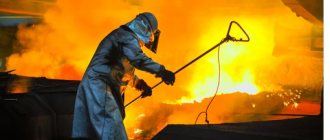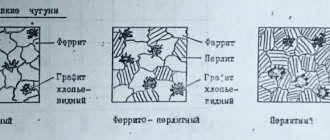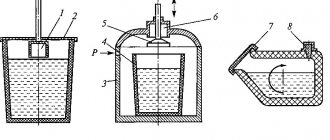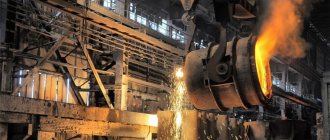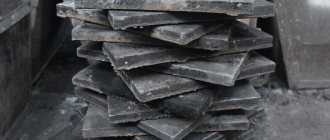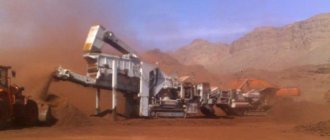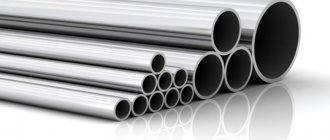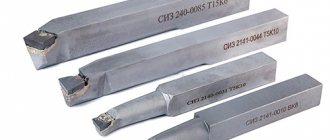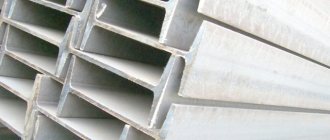“Iron casting” has been known to mankind since time immemorial. Nowadays, it is widely used in many areas of the national economy and is called cast iron. And while the average person may not know about crankshafts, gear housings, wheel hubs, fittings, everyone knows about frying pans, cast iron pots, radiators, bathtubs, grates and other cast iron products.
The metallurgical industry produces various simple and special types of cast iron, each of which has its own scope of application.
The use of cast iron and products made from it in construction and other areas
Cast iron is the main metal of ferrous metallurgy. It is an alloy of iron and carbon. Cast iron may contain special additives that make its properties special. This cast iron has the characteristics of wear resistance, corrosion resistance, heat resistance, non-magneticity and others. We will talk about the properties, composition and areas of application of gray, white, malleable cast iron, as well as high-strength and granular cast iron below.
Malleable
This alloy is a type of white cast iron, which is subjected to special firing in order to graphitize free carbon. Compared to steel, such cast iron has improved damping properties. In addition, it is not as sensitive to cuts and performs well in low temperature conditions. In such cast iron, the mass fraction of carbon is no more than 3.5%. In the alloy it is presented in the form of ferrite, granular pearlite containing inclusions of graphite or ferrite-pearlite. Malleable cast iron, like half cast iron, is used mainly in the production of parts operating under conditions of continuous friction. To improve the performance characteristics of the material, magnesium, tellurium and boron are added to the alloy.
Areas of application of cast iron
Due to its valuable properties, low cost and good casting characteristics, cast iron is used for the manufacture of various parts and objects. Cast iron can be used to produce products of interesting and special shapes, since this material has excellent hardness and strength. Made cast iron objects can withstand quite serious loads. It is for this reason that machine bodies and machine tool bases are made of cast iron.
- Cast iron has always been used for the manufacture of parts and heavy industrial . It was used in metallurgy and machine tool building. Moreover, this material was taken in very large quantities. It was used as the main one for small items and for large items, the weight of which reached hundreds of tons.
- in mechanical engineering . This is the type that is always taken for the manufacture of critical parts. Cast iron machine products resist vibration and vibration well.
- In the automotive industry, cylinder blocks are made from cast iron. These are critical parts that must have high strength and wear resistance. Cast iron helps to meet these qualities. To make these indicators optimal, special additives in the form of graphite are added to cast iron. Graphite increases the strength properties of the alloy several times. Additives make it possible to perfect cast iron and use it in the manufacture of diesel crankshafts.
- Brake pads are made from cast iron . We know that these parts operate under high friction. Cast iron helps them withstand these harsh conditions. In addition, rollers for flour-grinding and paper-making machines are made from cast iron.
- Cast iron products work well at low temperatures . For this purpose, malleable cast iron is used. It is used to make parts of tractors and complex mechanisms that will subsequently operate under harsh conditions.
- Cast iron is widely used to make household items . This material is very popular among our population. Cast iron pots, frying pans, cauldrons can be found both in an ordinary kitchen and in a restaurant's arsenal of dishes. This is truly unique tableware.
- Any housewife knows about a cast iron frying pan, which has excellent quality. Cast iron cookware retains heat well. It is convenient to prepare dishes that require constant warmth. Cast iron cookware is used to prepare pilaf, porridge and stew. The products in it retain a lot of useful properties. Carcinogenic substances are not formed in such food. By the way, it has been proven that cast iron cookware can enrich foods with useful iron elements.
- For the oil industry , a complex and dangerous industry, pipes are made only from cast iron. The products are obtained with high performance qualities.
- Cast iron is distinguished by its durability . Therefore, in our homes to this day you can see sinks and bathtubs that were made more than 50 years ago and are still being successfully used today.
- Cast iron is very often used for artistic objects . Various works of art are made from it. Thus, the embankment of St. Petersburg is almost entirely decorated with cast iron items. Interesting and unusual fences, openwork branched gates and cast iron monuments are made from cast iron. All this became possible thanks to the good casting properties of this material. The items made practically do not wear out and look the same even after many years. It is not uncommon to find cast iron works of art within the walls of a museum.
We will talk about the characteristics and areas of application of steels and cast irons (alloyed, antifriction, casting, etc.) below.
This video will tell you about the areas of application of cast iron:
What is the difference between cast iron and steel
Cast iron frying pans and cauldrons, the legendary cast iron radiators and bathtubs, steel knives and pots are items made from an alloy of iron and carbon (C). It would seem that the material is the same, but the difference is visible to the naked eye. Indeed, despite the same composition, these materials have different characteristics. So what is the difference between cast iron and steel, and can they be identified at home?
Main characteristics of steels
To determine the differences between cast iron and steel, you should consider each of these metals in more detail. Carbon is added to each of these alloys to obtain certain physical properties. It reduces the ductility and toughness of iron alloys, making them harder and stronger.
In steel, the C content does not exceed 2.14%. In addition to this, alloying components are added in the form of nickel, chromium, molybdenum, etc. Their amount should not exceed 53%.
This compound is plastic, making it easy to process. The quality improves during the hardening process. In addition, it has high thermal conductivity. The melting point varies between 1450°-1520°C.
Varieties
Before considering the difference between cast iron and steel and their differences, you should study their characteristics. Depending on the scope of application, steel connections are divided into the following types:
The structural type of connections has certain mechanical, physical and chemical properties. Depending on the amount of harmful impurities, the following subtypes are distinguished:
- ordinary (fluorine and sulfur content does not exceed 0.05%);
- high-quality (less than 0.035%);
- high quality (less than 0.025%);
- especially high quality (less than 0.015%).
Structural connections are used in construction and mechanical engineering. They are used to make various parts, mechanisms, and structures for mass use.
Main characteristics of cast iron products
Now we should consider how cast iron differs from steel in composition and properties. When picking up a cast iron frying pan, every housewife probably asked the question: “Is cast iron a metal or not?” This is a metal, and it consists of the same Fe and C. Only the proportion of carbon in it exceeds 2.14%.
That is, cast iron is an alloy of iron with carbon, which it contains in the form of cementite (iron carbide) or graphite (a mineral that is one of the modifications of C). It is these substances that determine the color of the finished product.
The melting point varies between 1160°C-1250°C and is directly dependent on the C content - the more of this substance, the lower the temperature. The relatively low melting point increases fluidity, impairing ductility, increasing brittleness and making further processing impossible.
The difference between steel and cast iron is that the latter cannot be processed by welding and forging. All products are manufactured only by casting.
Varieties
Depending on the form and quantity of these substances, this compound is divided into several subspecies.
White. This material contains cementite, which is white when broken. Therefore, this alloy has a light color. The carbon in it is in a bound form. And depending on its quantity, this material is divided into eutectic (C does not exceed 4.3%) and hypereutectic (C does not exceed 6.67%)
The white subtypes are mainly used to make malleable cast iron alloys obtained by annealing.
Grey. Here, almost the entire carbon component is contained in the form of flake graphite, giving it a gray tint. The composition includes silicon and permanent impurities in the form of magnesium, phosphorus and sulfur.
Malleable. Obtained as a result of prolonged annealing of a white material. During these manipulations, graphite is formed. The material got its name due to its increased plasticity and viscosity. The malleable variety is very durable with high impact resistance. Automotive parts are made from this material.
Highly durable. The structure of this type contains spherical graphite, which is formed during the crystallization process. Unlike flake graphite, spherical graphite does not weaken the metal base much, which improves the strength of the metal.
Ultimate. This type is subject to further processing and is not used as an independent metal.
Summarizing
Having examined the properties of cast iron and steel, we can begin to draw conclusions. The difference lies in the carbon content in steel and cast iron (there is less of it in the first alloy, more in the second).
Steel products have the following characteristics:
- increased hardness and strength;
- high melting point;
- higher specific gravity;
- ease of processing;
- high thermal conductivity.
Now we should consider what kind of metal is cast iron, and what are its characteristics. These include:
- fragility;
- lower melting point and specific gravity;
- low thermal conductivity;
- impossibility of processing.
Due to the high carbon content, all cast iron products are made by casting. This metal cannot be welded or forged. Unlike steel objects, they are gray in color and have a matte surface.
Steel products are light and shiny. Steel structures heat up and cool down quickly. Cast iron heats up very slowly and retains heat for a long time.
Although steel and cast iron contain similar components, their differences are obvious. These are two different metals with different properties and characteristics.
Source
Manufacturing technologies
As you know, cast iron is produced in special blast furnaces. The main raw material for its production is iron ore. The manufacturing process consists of the reduction of iron ore oxides and the resulting production of another material - cast iron. For its production, fuels such as coke, thermoanthracite, and natural gas are used.
To produce one ton of pig iron, about 550 kilograms of coke and approximately a ton of water are required. The volume of ore loaded into the furnace will depend on the iron content in it. As a rule, ore is used, which contains at least 70% iron. The thing is that it is not economically feasible to use a lower concentration.
The first stage in the production of cast iron is its smelting. Ore is poured into the blast furnace, and then coking coal, which is necessary to pump and maintain the required temperature inside the furnace shaft. During combustion, these components take an active part in the ongoing chemical reactions as iron reducers.
Meanwhile, flux is immersed in the furnace, which acts as a catalyst. By accelerating the melting of rocks, it thereby supports the rapid release of iron. It is important to know that before loading into the furnace, the ore undergoes the necessary pre-treatment. It is crushed in a crushing plant because smaller particles melt faster. It is then washed to remove non-metal particles. Next, the raw material is fired, as a result of which sulfur and other foreign components are extracted from it.
At the second stage of production, natural gas is supplied through special burners into the filled and ready-to-use furnace. Coke is involved in heating the raw materials. Carbon is released, which combines with oxygen to form an oxide. It, in turn, promotes the recovery of iron from ore.
As the volume of gas in the furnace increases, the rate of the chemical reaction decreases. It may even stop completely when a certain gas ratio is reached. Carbon penetrates the alloy and combines with iron to form cast iron. Unmelted elements remain on the surface and are soon removed. Such waste is called slag. It is used to make other materials.
First stage of production
Iron smelting occurs as follows. First of all, ore is poured into the furnace, as well as coking coal grades, which serve to pump and maintain the required temperature inside the furnace shaft. In addition, during the combustion process, these products actively take part in the ongoing chemical reactions as iron reducers.
At the same time, flux is loaded into the furnace, serving as a catalyst. It helps the rocks melt faster, which promotes the rapid release of iron.
It is important to note that the ore undergoes special pre-treatment before loading into the furnace. It is crushed in a crushing plant (small particles melt faster). Afterwards it is washed to remove particles that do not contain metal. After which the raw material is fired, due to this, sulfur and other foreign elements are removed from it.
Second stage of production
Natural gas is supplied to the loaded and ready-to-use furnace through special burners. Coke heats the raw material. This releases carbon, which combines with oxygen to form an oxide. This oxide subsequently takes part in the reduction of iron from the ore. Note that as the amount of gas in the furnace increases, the rate of the chemical reaction decreases, and when a certain ratio is reached, it stops altogether.
Excess carbon penetrates the melt and combines with iron, ultimately forming cast iron. All those elements that have not melted end up on the surface and are eventually removed. This waste is called slag. It can also be used to produce other materials. The types of cast iron obtained in this way are called foundry and conversion.
What is steel?
There is almost no tool/equipment in the world that does not contain steel. The material fits so tightly into the life of humanity that it is very problematic to imagine our existence without this alloy.
The first samples of the alloy were discovered in Turkey. The items are more than 3,700 years old, which means that steel items were popular even before our era. Wars of the past could not have happened without the use of steel weapons - cheap and durable. Industrial casting technology was developed in the early 19th century by Gentsman.
1) Structure and advantages of the alloy
| Advantages of steel | Disadvantages of the material |
| The material has a good margin of strength and hardness. | Weak corrosion resistance of pure steel grades without special alloying additives. |
| An abundance of properties due to the variability of filling pure iron with alloying impurities + processing methods. | |
| Elasticity with viscosity in an optimal ratio. Ideal for holding static, dynamic and shock loads. | Increased electromechanical corrosion due to the property of storing electrical energy. |
| Just slice, boil and fold. | |
| Long service life due to high safety margin. | Significant weight of steel structures + high risk of defects due to the multi-stage manufacturing process. |
| Simplicity and low cost of casting. |
China, Japan and India are considered the leaders in steel production. Russia is consistently among the top 5 countries in terms of production volumes, including. Taking into account the geography of leading producers, it is easy to guess that Asia is the leader in steel in the world.
Important: steel does not belong to pure chemical elements - it is a compound based on several.
A wide range of steel alloys with varying levels of strength, corrosion resistance and other unique characteristics is possible due to the material's "flexibility" in connection with other components.
Features of steel alloys:
- the mandatory presence of 2 components - carbon and iron. The first is responsible for viscosity, and the second is strength;
- With all the abundance of steel mining methods, completely pure variations of mining do not exist. Any alloy will have up to 1.2% silicon and up to 0.5% manganese. With minor inclusions, such impurities do not greatly affect the properties of the resulting alloy;
- To change the properties of the material, other metals are artificially introduced into the alloys in technologically specified proportions.
It is important to note that to change the characteristics of the alloy, sometimes it is enough to introduce only 5% of the alloying component. This diversity allows you to scale metal production at the owner’s discretion, based on demand or the level of competition within the local/global market.
2) Steel classification
The table below will tell you more about the distribution of steel alloys.
| Classifier | Components | Description |
| Chemistry | Carbon | The distribution occurs depending on the proportion of carbon content. For low-carbon steel types this is no more than 0.3%, and the peak value is no more than 0.7%. |
| Alloyed | Steels with additions of manganese, chromium, nickel, molybdenum and other elements. Low-alloy steel contains no more than 2.5% impurities, and high-alloy steel contains more than 10%. | |
| Structural composition | Perlite | Pure steel grades with a low content of carbon and alloy impurities. |
| Martensitic | Varieties of material with a large number and volume of additives. | |
| Autenite | High content of impurities - high-alloy steel grades. | |
| Deoxidizer | Calm | Steel without ferrous oxide impurities. Due to the high cost of production, it is used only in strategic units of metal structures. |
| Semi-calm | It hardens without boiling, however, there are small inclusions of gas bubbles. Some of them are removed during metal rolling. | |
| Boiling | Steel contains gases that are reflected in the characteristics of the material - cracks during welding and other defects. | |
| Purpose | Construction | Steel grades that require high-quality resistance to static/dynamic loads. The material must be easy to weld. |
| Instrumental | Steels with a high content of alloying components and carbon. There are stamping and cutting subtypes of tool steels. The material has high heat resistance, hardness + wear resistance. | |
| Structural | The composition contains low manganese content. Used to solve most routine tasks during construction. | |
| Impurities | Privates | The inclusion of sulfur is up to 0.06%, and phosphorus is up to 0.08%. |
| Quality | The inclusion of sulfur is up to 0.04%, and phosphorus is up to 0.033% | |
| High Quality | The inclusion of sulfur is up to 0.026%, and phosphorus is up to 0.023% | |
| Particularly high quality | The inclusion of sulfur is up to 0.014%, and phosphorus is up to 0.023% |
Thanks to adjustments to alloying inclusions + a specific manufacturing method, another 20 to 100 grades of material can be distinguished in each group.
3) Steel production + pricing
The table below will tell you about the methods for making steel.
| Method | The essence | Prevalence (out of 5 ★) |
| Martenovsky | It is based on the smelting of cast iron with ore in a special furnace at a temperature of more than 1,900 degrees Celsius - this allows you to burn off excess carbon. Alloying components are added at the end of the process. Next, the material goes for rental. | ★★★★★ |
| Converter-oxygen | Method with increased efficiency. Impurities are “blown out” of cast iron in a furnace using a mixture of oxygen and air. Annealing occurs faster + quality is higher. | ★★★★ |
| Electric melting | The material is melted at a temperature of more than 2,100 degrees. The process takes place in a closed furnace - this eliminates the access of gases. Due to its high cost, it is rarely used, and only for high-alloy grades. | ★★ |
| Straight | Pig iron is blown at the mining site. The fuel is natural gas - a mixture of oxygen, ammonia and other elements. Temperature range -1,000+ degrees. | ★★★ |
After using one of the methods, the steel making process is not completed. The result of the work should be a material with a high margin of safety, and it will not be possible to achieve such results without additional processing methods.
| Direction | Method | Description |
| Thermal | Annealing | Steel undergoes sharp temperature heating, after which it cools at different speeds. |
| Hardening | Overheating + rapid cooling. | |
| Vacation | Addition of hardening to reduce alloy stress. | |
| Normalization | Similar to annealing, but in air. | |
| Thermomechanical | High temperature | Mechanical action occurs while the material maintains heat. |
| Low temperature | Cold rolled steel. First there is heating, then partial cooling to a limit of 400-500 degrees, and further hardening. | |
| Thermochemical | Cementation | The upper part of the steel surface is saturated with carbon, which makes the crust more wear-resistant. |
| Nitriding | Incorporation of nitrogen into the material to obtain a top protective layer. | |
| Cyanidation | Combined saturation of nitrogen and carbon. |
The price of steel is as varied as the number of grades. For convenience, the exchanges use the term “standard steel” - from $230 per 1 ton of material. If we are talking about stainless steel grades, the cost can rise to $2,000 per 1,000 kg or more.
Story
The documented history of cast iron starts from the 1st millennium BC:
- Smelting was mastered by the Chinese and their neighbors.
- From the 5th century BC, the period of decorative iron casting began.
- 600 years later, coins appeared in China.
The appearance of the alloy in Europe dates back to the 14th century, in Russia – two hundred years later. Interest increased due to the suitability of cast iron as a material for cannons and cannonballs.
Eglinton Tournament Bridge (completed c. 1845), North Ayrshire, Scotland, built of cast iron
Since the time of Queen Victoria, fireplaces have become the most popular product in the “civil segment” among the British.
Cast iron coal iron
The heyday of the cast iron industry in Russia dates back to the 18th century:
- Bridges and rails appeared.
- Cast iron pots were invented in the Urals - the number one cookware for the Russian stove. Later they were supplemented with frying pans.
- By the end of the century, Russia had become the world leader in the production of cast iron.
The original bridge across the Tey from the north (finished in 1878)
The openwork products of Kasli craftsmen have gained world fame.
The method of molding for casting artistic castings of complex shapes, invented by the Kasli people, is still in demand by machine builders today.
What is cast iron?
The top 5 countries in terms of pig iron production include China, Japan, Russia, India and Korea. The high demand for the material is not only due to its domestic use. Cast iron is often used as a basis for the manufacture of steel alloys, which means that an extremely large volume of material is required.
| Advantages of cast iron | Disadvantages of the alloy |
| Some grades of cast iron have strength levels similar to steel. | With prolonged exposure to water, corrosion processes will begin on the surface of cast iron. |
| Uniform heat distribution + long-term storage. | |
| Eco-material, and therefore safe in the production of tableware. | The cost of cast iron is higher than classic steel. |
| It is resistant to acid-base environments. | |
| High level of hygiene. | Gray cast iron is not ductile, and white cast iron is too brittle. |
| Durability due to high corrosion resistance. |
There are 2 main types of cast iron - white and gray. The first is a material for the manufacture of malleable cast iron, and the second has wider areas of application both in industry and in everyday life.
You can see the features of alloy mining in the figure above. In the process of creating an alloy, the alloying additive plays an important role (as in the case of steel). There are hundreds of impurities, but the most popular are 4 elements.
Popular admixtures in the production of cast iron:
- sulfur. Reduces the level of refractoriness of a substance + reduces its fluidity in a liquid state;
- phosphorus. Reduces strength, but in return makes it possible to develop a product of a more complex shape;
- silicon. Reduces foundry temperature. The proportion of impurity changes the type of cast iron;
- manganese. Increases the strength of cast iron, but negatively affects the casting and technological properties of the alloy.
In addition to the above list, titanium, nickel, copper and aluminum are often added. Impurities affect both the chemical properties of cast iron and its physics and structure. In the latter case, there is a special classification - pearlitic, ferritic and pearlitic-ferritic varieties of cast iron.
The difference lies in the microstructure of graphite - spherical, plastic, flake or vermicular. The latter form was created specifically to improve the quality characteristics of gray cast iron.
Areas of application of cast iron:
- basis for crankshafts and engine blocks. It has also proven itself in the production of brake pads;
- one of the positive properties of cast iron is its resistance to temperatures, which allows the material to be used in the manufacture of equipment that is aimed at harsh climates with low temperatures;
- products in metallurgy are valued for adequate strength with high wear resistance;
- The household uses of cast iron are known to everyone - sinks, radiators, sinks, and so on. More expensive than regular steel, but much higher quality.
The material has even found its place among lovers of beauty. Cast iron is a classic material for works of art related in any way to metals in general. And forged gates are a sign of wealth to this day.
Industry challenges
Today, cast iron casting has dubious prospects. The fact is that due to high costs and large amounts of waste, industrialists are increasingly abandoning cast iron in favor of cheap substitutes. Thanks to the rapid development of science, it has long been possible to obtain higher quality materials at lower costs. Environmental protection plays a major role in this issue and does not accept the use of blast furnaces. It will take years, if not decades, to completely convert iron smelting to electric furnaces. Why so long? Because it is very expensive, and not every state can afford it. Therefore, all that remains is to wait until mass production of new alloys is established. Of course, it will not be possible to completely stop the industrial use of cast iron in the near future. But it is obvious that the scale of its production will fall every year. This trend began 5-7 years ago.
What are the similarities and differences between steel and cast iron?
It is useful to know what the difference between materials is for housewives, because cast iron products are much more expensive than their steel counterparts. It will be a shame to overpay 3-5 times, and in the end, to get deceived by a persistent market trader.
1) Similarity/difference of basic characteristics
What cast iron and steel have in common is the material category. Both the first and second contain carbon and iron. This is where the common features of the alloys end. Even when adding the same amount of alloying elements, the resulting result in terms of characteristics will not be 100% or even 80% similar.
Now for the differences. To make it easier to understand, we will present the data in table form.
| Characteristic | Steel | Cast iron |
| Proportion of carbon in the alloy | More than 2% | Less than 2% |
| The content of non-metallic impurities - sulfur, phosphorus, magnesium and so on. | Minimum | A large number of |
| Fragility | Average | Strong |
| Hardness level | High | Average |
| Strength | Above cast iron | — |
| Malleability level | Above cast iron | — |
| Easy casting | — | Above steel |
| Thermal conductivity | — | Above steel |
| Hardening | Need | Not necessary |
| Processing methods | More cast iron | — |
| Weight | — | More steel |
Already based on the information presented above, you can draw certain conclusions, even just by holding two samples of materials in your hands. The most important distinguishing feature at the composition level is the proportion of carbon. If the alloy contains 2.5% of this element, the alloy is considered cast iron, not steel.
Methods for determining steel and cast iron at home:
Mechanical Features
Tensile strength
The compressive strength of cast iron depends on the structure of the material itself. The components of the structure gain their strength along with an increase in the level of dispersion. The tensile strength is strongly influenced by the number, size, distribution and formagraphite inclusions. The tensile strength decreases by a noticeable amount if the graphite inclusions are arranged in the form of a chain. This arrangement reduces the cohesion of the metal mass. The tensile strength reaches its maximum value when the graphite takes on a spheroidal shape. This form is obtained without the influence of temperature, but when cerium and magnesium are included in the cast iron mass.
- When the melting temperature increases to 400ºС, the tensile strength does not change.
- If the temperature rises above this value, the tensile strength decreases.
- Note that at temperatures from 100 to 200ºС, the tensile strength can decrease by 10-15%.
Plastic
The ductility of cast iron largely depends on the shape of the graphite, and also depends on the structure of the metal mass. If graphite inclusions have a spheroidal shape, then the percentage of elongation can reach 30.
- In ordinary gray cast iron, the elongation reaches only a tenth.
- In annealed gray cast iron, the elongation is 1.5%.
Elasticity depends on the shape of the graphite. If the graphite inclusions did not change, and the temperature increased, then the elasticity remains at the same value.
The elastic modulus is considered a conditional value, since it has a relative value and directly depends on the presence of graphite inclusions. The elastic modulus decreases if the number of graphite inclusions increases. Also, the elastic modulus increases if the shape of the inclusions is distant from the globular shape.
Impact strength
This indicator reflects the dynamic properties of the material. The impact strength of cast iron increases:
- when the shape of graphite inclusions is close to spherical;
- when the ferrite content increases;
- when the graphite content decreases.
Endurance limit
The endurance limit of cast iron becomes greater when the frequency of loading increases and the tensile strength becomes greater.
